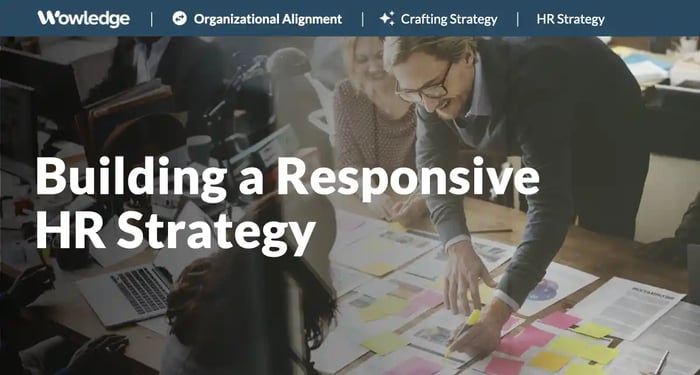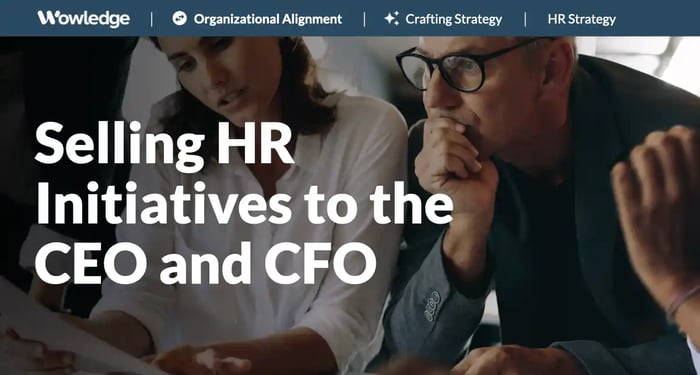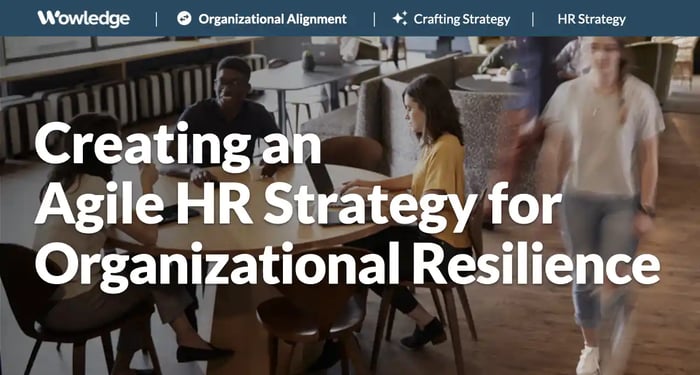Table of Contents
- How to approach planning for a year that has already begun
- Create a formal plan from scratch, and in a hurry
- 1. Understand the direction in which the business is heading
- 2. Identify external and internal enablers and barriers to success
- 3. Engage with top leadership to evaluate key opportunities for contribution
- 4. Generate HR objectives linked to business and people goals and challenges
- 5. Document and communicate the plan
- Update a previous year’s plan quickly
- Adopt more advanced plan elements
- Consider the HR Delivery model and organizational structure
- A lesson learned as a final thought
- Relevant Practices & Tools
- FAQs
As the head of the HR or People function, do you have a formal corporate HR Strategic plan for the year ahead? If you are an HRBP, is there one for the company but not for your business unit? While each of these is very common, and the lack of a plan may or may not be noticed by your business leader(s), the HR team is missing out on a significant opportunity to communicate how it will align with and address the business and people challenges facing the organization through its HR strategy.
A formalized HR plan is the primary currency of strategic human resources management and business-aligned HR leaders, functions, and teams. It demonstrates a focus on delivering value and contributing directly to the operational and financial success of the organization. When addressed properly, such a plan also positions HR as a strategic partner rather than just a support organization.
How to approach planning for a year that has already begun
While the new calendar year has already begun, the business year may or may not have. If your fiscal and planning years do not start until March or April, there is still plenty of time to create an HR strategy for the coming year. However, as many organizations’ fiscal and planning years coincide with the calendar year, creating a plan is still not too late.
The plan does not necessarily need to be an all-encompassing document with dozens or hundreds of pages. Still, it should be strategic and comprehensive and, wherever possible, incorporate data that explains the past and informs the future. There is a simpler but effective approach that incorporates best practice considerations that are core to building a great plan. The elements that define an effective plan include reviewing external market/industry trends, engaging with/getting input from business leadership, understanding the business/operations directions for the new year, and converting those into clear HR objectives and initiatives. The resulting document can be as brief as a few pages of text or a handful of PowerPoint slides that clearly demonstrate the linkages between the planned HR goals and objectives and the business challenges and goals for the upcoming performance period. The use of data to support assumptions and articulate goals adds to the credibility and measurability of HR contributions.

Create a formal plan from scratch, and in a hurry
Remember that an HR strategy can be built at any time of the year. In fact, given the current volatility in the business and labor markets, this might work to your advantage when building an updated and time-relevant plan. To create a plan that will provide context to HR’s efforts in the coming year, the most fundamental steps to create a plan include:
1. Understand the direction in which the business is heading
There are two ways to do this: document reviews or structured conversations with business leaders.
a) Collect and review available strategic documents. Does a corporate and/or a business unit strategic plan for the new year exist? Can it be accessed? If a formal plan has been developed, it should be reviewed for a list of business priorities and initiatives, assumptions used for projected results, and clear statements of goals or objectives.
b) Meet with/interview top leadership. Use a structured interview to ascertain key directions, goals, and planned initiatives. Dig in beyond their first responses with thoughtful follow-up questions to understand the rationale and assumptions behind the stated plans and objectives.
2. Identify external and internal enablers and barriers to success
Either as part of the document review or interviews, seek to understand the external (economic climate, industry, your products/services’ consumer trends) and internal (recruiting, engagement, retention, etc.) factors that will either support or deduct from the company’s ability to meet its primary goals. Consider the quality of the employee experience and the opportunities for improvement there. Take advantage of free access to economic and industry data and related insights from government agencies and talent trend data from HRIS and talent management systems. That said, interviews with internal experts (e.g., COO, CFO) can be used to more readily fill the gaps if time and resources are limited.
3. Engage with top leadership to evaluate key opportunities for contribution
Meeting formally with the top leaders to review insights and answer questions about how HR can contribute to achieving primary business objectives is a vital step of the process. In an ideal world, the HR leader is included in the corporate strategic planning development effort and has goals jointly developed from that effort. Lacking such a process or involvement in one, coming to the table with a draft summary of business and people issues and the enablers/barriers analysis, no matter how simplified it is, demonstrates HR’s focus on impacting business objectives. The outcomes of such a meeting also bring shared ownership and some level of governance into the HR agenda.
4. Generate HR objectives linked to business and people goals and challenges
The creation and documentation of HR goals and objectives should directly translate how HR will work to impact the company’s primary goals and initiatives, plus any plans for improving HR processes, practices, and programs. As a rule of thumb, HR should take on 2-3 improvement initiatives annually that will directly impact its efficiency, effectiveness, and/or the employee experience. Think of this similarly to individual performance management goals, with 2-3 goals as contributions to team or functional success and 2-3 personal development goals.
5. Document and communicate the plan
A plan is of little use when left on a shelf. It should be communicated broadly to top and middle management, with clear goals and linkages to specific business goals. The goals should be shared with all HR teams, with flexibility encouraged for adaptation to meet business unit or local requirements.

Update a previous year’s plan quickly
If you have a strategic HR plan from last year, it is simpler to update that. It still requires a review of the company's direction and what is happening in the relevant external and internal environments. If operating off a previous year’s comprehensive plan, it should be updated to reflect what is known and projected to occur during the coming year. Those steps include:
1. Review the prior year’s business environment assumptions
Revisit business objectives and the extent to which they were met and/or continue to require attention and changes in the relevant external economic, business, regulatory, and consumer environments. Updates will likely be required for business goals, as with any changes in the externalities, to make them timely and instructive to leaders in HR and the business. Core to this is the translation of these trends into HR- or people-relevant insights for quality goal setting.
2. Analyze people and HR process data
Take a detailed look at the data from the prior year for internal opportunities in HR practices, processes, and programs. Identify whether there have been significant changes that need to be addressed. Examples include the observation of below-expectation performances on HR efficiency (time to fill, learners per course), effectiveness (unique successors per executive role, diversity candidates per management role), or business impact (revenue per coached vs. uncoached salesperson, cost savings achieved from HRIS implementation). Any notable lack of change or progress towards improved conditions should also be managed.
3. Evaluate HR process maturity and opportunities
Plans should include formal reviews of specific HR processes, such as performance management or recruiting, to collect data on and enhance end-user experience, including applicants, employees, managers, and administrators. Leading practice calls for a formal review of each critical HR process on a rolling (staggered) basis. Often, this calls for evaluating the technology(s) employed to improve the time and effort required to complete a process.
4. Engage top leadership
As stated above, meet with top leadership while (ideally) updating the plan and, at minimum, reviewing the new year’s draft plan. Meeting with (top and functional) leaders as part of the plan development process to collect insights and objectives for the new year is an essential element of quality planning. In fact, reviewing initial thoughts and collaborating on ideas about how HR can impact those is an excellent test of ideas before they are included in the plan.
5. Document and communicate the plan
Once the plan is finalized, ensure it is thoroughly documented and clearly communicated to all relevant stakeholders. This includes creating detailed documentation that outlines the updated objectives, strategies, and action items, conducting meetings, or sending comprehensive communications to ensure everyone understands the plan and their role in its execution. Effective documentation and communication help align the entire organization with the updated HR strategy and ensure successful implementation. This is a crucial element of any planning cycle that is often overlooked.

Adopt more advanced plan elements
Naturally, a more advanced and comprehensive plan is desirable, as it completely documents the thinking and considerations that support a broader corporate strategic planning effort. Such HR strategy planning guidance is available for subscribing members of Wowledge. However, options exist for more advanced elements that can be incorporated into an abbreviated HR plan for added strategic business value. Those include:
Conducting a critical workforce segmentation exercise
Such an analysis categorizes all jobs into one of four quadrants according to their relative value (or criticality) to the business and scarcity (difficulty to hire and replace). These roles tend to include no more than 7-10% of the total jobs in an organization and, as such, enable the HR team to target planning efforts more efficiently for tracking and special programs on a smaller portion of the workforce.
Bringing employee experience analyses into the plan
Leverage methodologies such as design thinking, Lean approaches, user experience, etc., to review and improve the construction of essential processes, practices, and programs from an employee perspective. More effectiveness in critical practices can support employee engagement and retention efforts.
Broadening people measurement schemes
Engage internal or external partners to bring employee listening and/or advanced people analytics into the HR plan. Leveraging employee or pulse surveys, focus groups, employee resource groups, and skip-level sensing meetings bring up-to-the-minute insights and feedback on employee issues, concerns, and perceptions helpful in maintaining an engaged workforce. Analytics that link HR processes and programs to talent and business outcomes add tremendous value to the business, with unique insights into employee preferences. The plan should incorporate lagging (retrospective) and leading (or predictive) indicators that can be tested for their insight value with business leaders.
Consider the HR Delivery model and organizational structure
On at least an annual basis, the HR strategy should include a review of the allocation and placement of HR staff should be reviewed to ensure the proper alignment of resources in places where the impact of services can be delivered best. Included in this should be considerations related to career development, the adoption or upgrading of technologies, and the use of contingent or purchased labor to fill in capability gaps or short-term needs.
A lesson learned as a final thought
Strategic planning is a skill set that, in our experience, is a shortcoming in many HR professionals. While many experts focus on technical capabilities as priorities for development, we have observed that HR professionals (in companies from F500 down to start-ups) need to develop a broader understanding of the business and its primary drivers and learn to translate the goals and performance gaps into specific and impactful HR objectives. We attribute this to a general lack of planning, experience, and requirements to create annual plans at the business unit (e.g., HRBP) level.
It is a correctable shortcoming that extends the typical creation of a local force field, SWOT, or related analysis. Such assessments yield a list of challenges or organizational weaknesses that must be addressed to meet business goals. Alternatively, bringing the HR team together on an annual basis to jointly review and discuss corporate goals and initiatives, external and internal analyses, and then brainstorming HR responses to those in a guided or facilitated fashion can start to create a cadre of strategic business thinkers and actors. This can only enhance HR’s profile as a solid business partner worthy of a seat at the proverbial "table."
Relevant Practices & Tools
Core HR Strategy Practices to Define a Foundational Direction for the HR Function. >
An HR Strategy defines the process of identifying business-based human resource (HR) tactics that will constitute a comprehensive multi-year approach to the management... more »
Understanding Business Strategies to Align the HR Direction. >
Core to the development of an HR strategy is building an understanding of the key business strategies and initiatives that must be accomplished during the term of the plan... more »
Assessing External and Internal Business Trends, Pressures, and Drivers of HR Strategy. >
An important step in the development of a comprehensive HR strategy is researching and determining factors that are currently (or projected to be) operating in an environment... more »
Developing a Base Strategy that Provides Guidance on HR Direction, Initiatives, Objectives, and Goals. >
Developing a plan involves leveraging the outcomes of the various discovery activities, organizing them into a logical flow, and translating those insights into HR responses and objectives... more »
The Goals & Trends Conversion Tool: Translate Barriers and Enablers into HR Challenges for the Development of Strategic Objectives. >
This tool is used in a succession of analyses to take identified external and internal business trends and strategic goals and convert them into HR objectives closely aligned with business... more »
FAQs
How can HR objectively prioritize objectives when capacity is constrained?
A simple scoring model can assign each initiative a score based on a combination of its business impact, time sensitivity, resource intensity, and risk reduction. Items tied directly to specific corporate priority outcomes or regulatory exposure receive higher weight, while those that build long-term operational capabilities receive a protected allocation to avoid any short-term biases. The model is reviewed with senior leaders to confirm trade-offs and obtain their explicit support and sponsorship. Portfolio limits are set so that teams carry no more than two transformational (long-term, strategic) and two incremental (short-term, operational improvement) efforts at once.
What governance approach keeps HR and business aligned throughout the year?
A tiered set of leadership reviews works best. For example, conducting monthly operational reviews with line managers to understand changes in critical metrics and KPIs, quarterly portfolio reviews with senior leaders to reprioritize goals and initiatives, and semiannual strategy sessions with top leaders and functional experts to reset assumptions. Each initiative names a business sponsor and an HR owner, with a brief charter that defines the problem, scope, milestones, and value measures. Decisions are recorded in a shared log to preserve continuity across leadership changes. Escalation paths are defined in advance for budget, policy, or technology conflicts.
How should workforce segmentation translate into differentiated programs and budgets?
Strategically critical and scarce (or hard to recruit and replace) roles receive prioritized investments in sourcing, career pathways, and retention mechanisms such as targeted development and differentiated rewards. Stable, non-scarce roles focus on efficiency, standardization, and cross-training to reduce operating risk. Budget allocation follows segment value, not headcount share, and is justified through scenario assessments (e.g., statistically modelled) of the impact on revenue, customer outcomes, or operational continuity. Success is tracked by time-to-productivity, internal fill rates for critical roles, retention rates, and risk exposure from vacancies.
How can HR ensure consistency while allowing business units to localize the plan?
The enterprise HR plan defines the “non-negotiables”—common principles, metrics, and core processes—while business unit plans select from a modular menu of initiatives aligned to local needs. Flexibility comes in the form of HRBP translation of enterprise outcomes into unit-specific targets and defining local improvement or development initiatives that align with shared metrics. Central teams provide tools, data definitions, and enablement, and business unit results feed back into enterprise dashboards for comparability. Variance from standards is permitted only with a documented business case and a pre-defined review timeframe.









